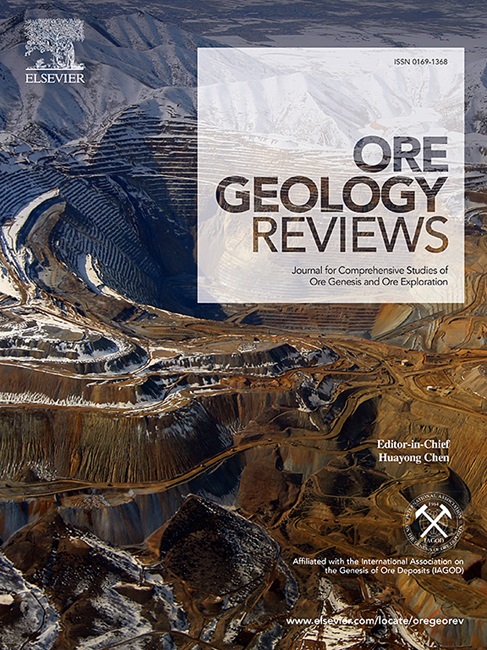Trace elemental systematics of auriferous sulfides within the dolerites of northern Cuddapah Basin, southern India: Implications for invisible gold mineralization
IF 3.2
2区 地球科学
Q1 GEOLOGY
引用次数: 0
Abstract
In the present work, the trace elemental systematics of the dolerite-hosted auriferous sulfides have been carried out to understand the nature of invisible gold mineralization within the northern part of Cuddapah Basin, southern India. The whole-rock geochemistry suggests that the dolerite is derived from a spinel peridotite mantle source and emplaced as a result of the intraplate magmatic activities. Within the dolerite, pyrite is the dominant phase associated with chalcopyrite and magnetite. Two types of pyrite phases are identified on the basis of their textures, i.e. Py1 and Py2. Py1 is anhedral to subhedral, whereas Py2 is euhedral. The Co/Ni ratio of Py1 and Py2 suggest their hydrothermal and volcanic origin, respectively. The gold vs arsenic plot indicates that gold occurs as solid solution within pyrite. Py1 is comparatively enriched in gold than Py2. Along with gold, other trace elements like As, Se, Ga, Ge, Sb, Te, and Ti are also present within these pyrite phases. The positive correlation of the gold with these trace elements indicates its solid solution nature. Py2 has a lesser content of gold than Py1, because of the higher ambient temperature. This work is the first report on the invisible gold occurrences within the dolerite hosted sulfides and provides new insights into the gold metallogeny of the northern Cuddapah Basin. The findings also contribute to the broader understanding of the trace elemental behavior in ore-forming processes, particularly in the context of invisible gold within sulfide minerals, which may have exploration implications in this region.

印度南部Cuddapah盆地北部白云岩中含金硫化物的微量元素系统:对不可见金矿化的启示
本文对印度南部Cuddapah盆地北部白云岩含金硫化物进行了微量元素系统学研究,以了解隐藏式金矿化的性质。全岩地球化学特征表明,该白云岩起源于尖晶石橄榄岩地幔源,是板内岩浆活动的结果。白云岩中以黄铁矿为主,伴生黄铜矿和磁铁矿。根据黄铁矿的结构,确定了两种类型的黄铁矿相:Py1和Py2。Py1是正面体到亚面体,而Py2是自面体。Py1和Py2的Co/Ni比值分别显示其热液和火山成因。金与砷图表明,金以固溶体形式存在于黄铁矿中。Py1的金含量比Py2高。除金外,其他微量元素如As、Se、Ga、Ge、Sb、Te和Ti也存在于这些黄铁矿相中。金与这些微量元素呈正相关关系,表明金具有固溶体性质。Py2的金含量比Py1少,因为环境温度较高。本文首次报道了玄武岩型硫化物中不可见金的赋存,为库达巴盆地北部金矿成矿提供了新的认识。这些发现也有助于更广泛地了解成矿过程中微量元素的行为,特别是在硫化矿物中不可见金的背景下,这可能对该地区的勘探具有指导意义。
本文章由计算机程序翻译,如有差异,请以英文原文为准。
求助全文
约1分钟内获得全文
求助全文
来源期刊

Ore Geology Reviews
地学-地质学
CiteScore
6.50
自引率
27.30%
发文量
546
审稿时长
22.9 weeks
期刊介绍:
Ore Geology Reviews aims to familiarize all earth scientists with recent advances in a number of interconnected disciplines related to the study of, and search for, ore deposits. The reviews range from brief to longer contributions, but the journal preferentially publishes manuscripts that fill the niche between the commonly shorter journal articles and the comprehensive book coverages, and thus has a special appeal to many authors and readers.
 求助内容:
求助内容: 应助结果提醒方式:
应助结果提醒方式:


